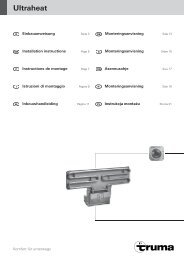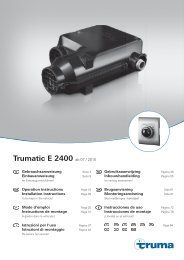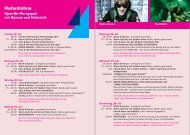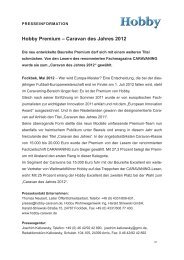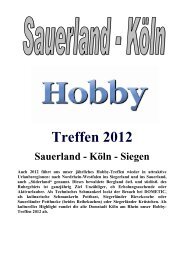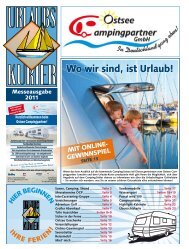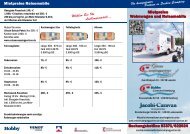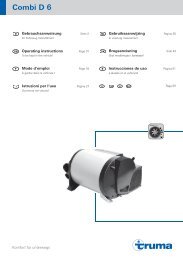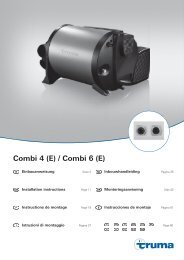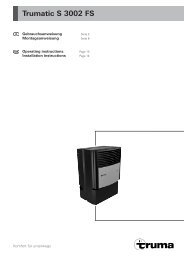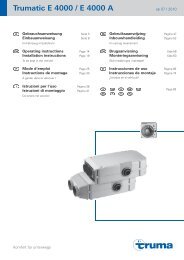Trumatic S 2200 / S 2200 P - Ostsee Campingpartner
Trumatic S 2200 / S 2200 P - Ostsee Campingpartner
Trumatic S 2200 / S 2200 P - Ostsee Campingpartner
Create successful ePaper yourself
Turn your PDF publications into a flip-book with our unique Google optimized e-Paper software.
For further details on the specifications in the respective<br />
countries of destination, contact our agencies abroad (see<br />
Truma Service Booklet or www.truma.com).<br />
The combustion air must not be taken from the vehicle<br />
interior. The combustion air must always be obtained<br />
from the outside.<br />
Choice of location<br />
1. Always install the appliance and its exhaust gas duct in<br />
such a way that it is easily accessible for service work at all<br />
times and can be removed and installed easily.<br />
2. The heater can be installed in the wardrobe with the installation<br />
box (fig. D1) or it can stand on its own – if necessary<br />
fitted with a rear panel (fig. D2). When choosing the location,<br />
make sure that the holes can be applied according to the<br />
template. As standard version, the exhaust duct connection is<br />
arranged on the left side (control knob on the right).<br />
The appliance is also available with the exhaust duct on the<br />
right side, upon special request.<br />
3. Exhaust ducts and cowls must be installed in such<br />
a way that exhaust gas cannot find its way into the vehicle.<br />
The intake duct for combustion air (with exhaust<br />
duct routing via the roof) is not to be in the spray area<br />
of the wheels, attach a spray guard, if necessary.<br />
Exhaust gas and combustion air are routed<br />
through the side wall<br />
Fig. E<br />
The cowl must be attached such that there is no fuel<br />
tank filler neck or fuel tank breather opening within 500 mm<br />
(A). When selecting the location, ensure that there are no<br />
opening windows, hatches or ventilation openings leading to<br />
the living compartment directly above and 300 mm to the side.<br />
To ensure safe operation it is absolutely necessary that<br />
the cowls for exhaust gas and combustion air be placed<br />
at the prescribed height. This height (the distance between<br />
the heater base and the centre of the exhaust cowl opening)<br />
depends on the duct lengths used.<br />
To ensure an even and rapid warm air distribution as well<br />
as lower surface temperatures on the heater, we recommend<br />
installing a Trumavent warm air system.<br />
Installation of the heater<br />
– Installation in the wardrobe using the installation box<br />
EKM<br />
1. Cut out a section in the front of the wardrobe measuring<br />
440 mm in height and 480 mm in width. Provisionally insert<br />
installation box in the cutout section.<br />
2. Place floor template in the installation box so that it fits into<br />
the rear corners exactly (L = left exhaust duct connection,<br />
R = right exhaust duct connection) and fasten with thumb<br />
tacks. Take out installation box again.<br />
3. Drill floor opening with 15 mm diameter for the condensation<br />
water drain and mark the 4 positions for the fastening<br />
screws according to the template.<br />
4. Only for exhaust duct routing via the roof: Drill a hole<br />
with 65 mm diameter for the combustion air intake duct.<br />
The specified dimensions must be observed exactly!<br />
5. Reinstall the installation box and screw on. Punch out the<br />
perforated opening for leading through the exhaust duct on<br />
the left (1) or on the right (2 – refer to fig. D1).<br />
12<br />
– Freestanding installation<br />
1. Place floor template in the chosen position.<br />
2. Drill an opening of 15 mm diameter in the floor for the condensation<br />
water drain and mark the 4 positions for the fastening<br />
screws.<br />
3. Only for exhaust duct routing via the roof: Drill a hole<br />
with 65 mm diameter for the combustion air intake duct.<br />
The specified dimensions must be observed exactly!<br />
If the back of the free-standing heater is exposed, or if there<br />
are parts made of wood in the area of heat radiation, we<br />
recommend fitting a rear panel (fig. D2).<br />
Exhaust gas and combustion air routing<br />
through the side wall (cowl kit AKW)<br />
Only Truma stainless steel flue gas pipe AE 3 may be used<br />
with the <strong>Trumatic</strong> S <strong>2200</strong> (part no. 30140-00) with Truma insulating<br />
duct ÜR (APP – part no. 40230-00), since the heater has<br />
only been tested and approved in combination with these pipes.<br />
Fig. F<br />
Fitting and bending the stainless steel duct and stretching<br />
open the O-ring are facilitated considerably using the “Biege-<br />
Boy“ (part no. 30030-33000).<br />
Cowl opening AKW<br />
Assemble the wall cowls on a surface which is as flat as<br />
possible and which is exposed to wind from all sides.<br />
Drill out the two cowl openings with 79 mm diameter, as<br />
specified for the following installation variants (A, B or C), (if<br />
there are hollow cavities in the area of the cowl opening, pack<br />
these cavities with wood) and make holes for the wall screws.<br />
The specified minimum height must be observed exactly<br />
(= distance between heater base and centre of exhaust<br />
cowl opening)!<br />
Fig. G1<br />
Installation variant A:<br />
With duct lengths of up to 35 cm (the ducts must be led<br />
through the side of the heater casing) the minimum height<br />
for installation of the exhaust cowl is 20 cm. For this purpose,<br />
fold the wall template at the broken line, let fold rest on<br />
the floor.<br />
Installation variant B:<br />
With duct lengths of up to 75 cm the exhaust gas cowl<br />
must be installed at a minimum height of 33 cm.<br />
For this purpose let the wall template rest on the floor.<br />
Installation variant C:<br />
With duct lengths of up to 120 cm the exhaust cowl must<br />
be installed at a minimum height 66 cm (measure between<br />
base of heater and centre of exhaust gas cowl opening).<br />
The ducts can be made shorter, however the minimum distance<br />
between the cowls (11,5 cm) is not to be fallen short of.<br />
If it should prove necessary, the cowls can be installed at up<br />
to a distance of max. 22 cm. With the installation variants B<br />
and C the ducts can be bent to the side, through the heater<br />
casing or to the rear. The double support DSW must be<br />
installed. If necessary, the support can be made shorter by<br />
cutting or bending.<br />
Duct connection to the heater<br />
1. Fig. G1<br />
Release the two screws (1) on the top of the heater and remove<br />
casing.<br />
2. Fig. G2<br />
Connect exhaust duct (2) to the upper heater connection fitting<br />
(3) as follows: Slide sealing plate (4) approx. 3 cm up the



